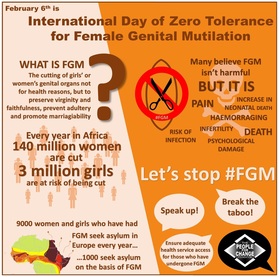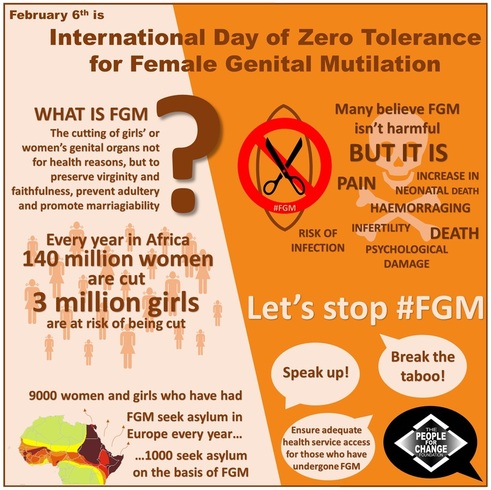Female Genital Mutilation
|
February 6th is the International Day of Zero Tolerance of Female Genital Mutilation (FGM). Read our commemorative press statement here.
FGM is internationally recognized as a procedure that violates the human rights of girls and women. The procedure, that is mainly carried out on minors, not only violates women’s and children’s rights but also their rights to health, security and physical integrity, the right to be free from torture and cruel, inhumane or degrading treatment. FGM can also result in death, violating one’s right to life, yet it is still carried out in more than 29 countries across the globe. On this day, The People for Change Foundation calls for more concerted efforts to combat female genital mutilation globally and to better address the needs of persons who have been victims of FGM. In January, 2014 FGM became a criminal offence in Malta through an amendment to the Criminal Code. However Malta still needs to develop guidelines, educational campaigns and robust prevention polices to address this issue. |
What is FGM?
According to the World Health Organization’s (WHO) description, female genital mutilation (FGM), also known as Female Genital Cutting or Female Genital Circumcision (FGC), comprises all procedures that involve partial or total removal of the external female genitalia, or other injury to the female genital organs for non-medical reasons. All three terms describe the partial or total removal of the external female genitalia. The names for the procedures have come under debate as the word “mutilation” is seen by many as too graphic a term which could stigmatize those who practice it, while other believe it is right in order to highlight not only the act but its violation of women’s human rights. FGM or FGC have been classified into four major types; clitoridectomy, excision, infibulation, and all other harmful procedures to the female genitalia for non-medical purposes.
What is the purpose of FGM?
There are no health benefits to FGM, in fact it actually can cause harm to girls and women who undergo the procedures. FGM is mainly carried out due to cultural, religious and social factors. Different communities perform different types of FGM depending on their customs, culture and tradition, providing different reasons for the procedures. There is however a common factor in that social pressure plays a big part in the continued practice of FGM across generations. Some of the reasons given include; protecting family honour, preserving tradition, ensuring a woman’s chastity, cleanliness and a preparation for marriage. FGM has also been strongly associated with religious practices but is carried out among Christian and Muslim communities alike. No religious scripture has been found to prescribe FGM and there is differing opinion among religious leaders from the areas in which it is carried out.
Who practices FGM and whom does it affect?
Although concentrated in Western, Eastern, and North-Eastern regions of Africa, the practice is also carried out in some countries in Asia and the Middle East as well as among migrant communities from these areas. The practice is mostly carried out by traditional circumcisers in many communities but the trend towards medicalization of the procedures has been increasing, with 18% of all FGM being performed by health care providers, according to a UNICEF overview in 2013. It is usually carried out on girls when they are between infancy and 15 years old but occasionally also on young women. It has been reported that it is being performed on younger children as their parents believe it might reduce the trauma as well as be met with less resistance than when the girls grow up.
What are the health effects of FGM?
FGM can cause immediate and long term chronic health effects. Intense pain and hemorrhages can often lead to shock either during or after the procedure. Wounds are often infected, including with tetanus which is fatal in 50-60% of cases, especially when the procedure is performed in an area that does not have antibiotics and ill-equipped medical facilities. Long term effects include but are not limited to abnormal menstruation, recurrent urinary tract infections, infertility, psychological problems, increased risk for HIV and the inability to enjoy sex.
What has been the international response?
- As a part of the African Charter on Human and People’s Rights, the African Union issued “The Maputo Protocol” which obligates states to take all necessary steps to eliminate such practices, including creating public awareness through outreach and education, prohibiting all forms of FGM/C, and supporting victims and protecting women at risk. However, as of 2012, 10 of the 15 partners ratified the protocol, only 7 reported any actual enforcement.
- Within the EU, the END FGM Campaign has been advocating for a strategy to end FGM in Europe. In June 2012, the European Parliament passed a resolution to end FGM in Europe and abroad through prevention, protection measures and legislation. In 2013, the European Commission released its first action plan against ending FGM and it has facilitated high level and civil society discussions about the issue.. Furthermore, key directives adopted by the EU address FGM including the Victim’s Rights Directive, the Asylum Reception Conditions Directive, and the Asylum Qualification Directive.
- The UNFPA and UNICEF have launched a Joint Partnership to accelerate the abandonment of FGM, focusing on 17 African countries in West, East and North Africa. Their main efforts are supporting national, regional and global initiatives.
- Various international development agencies have provided technical assistance, advocacy, and funding including PATH, RAINBE, Equality Now, and Women’s International Network.



